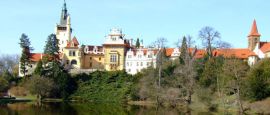The self-proclaimed "Republic" of Užupis was once a slum but now a Bohemian and artistic district with excellent bars and restaurants. It has its own anthem, constitution (translated into many languages and each plaque is on display on the long wall on Paupio Lane), president, bishop, two churches, seven bridges and its own guardian called the Angel of Užupis. On its 'Independence Day', April 1, beer flows from the fountain by the Angel for an hour.
Things to see in Vilnius
Tourist offices
Address: Rodūnios 2, Vilnius, Lithuania
Tel: +370 (5) 262 9660
Opening Hours:
Daily: 0900-1800
www.vilnius-tourism.ltThe sprawling old town was in a sorry state once with crumbling facades and an air of general decay. The picture now is completely different with the buildings around central Didzioji positively gleaming. Aimless wandering is usually rewarded.
A picturesque town gate and tower that has become one of the city's best-known sights. There were once 10 gates leading into the Old Town - this is the only one remaining, and today plays home to a chapel which is open to the public. Said to have miracle-working powers, people come from far and wide to pray to the painting of the Blessed Virgin Mary inside the chapel.
A short walk (or an even quicker ride up the funicular) brings you up to the small mound where the only remaining tower of the city's upper castle nestles. The original 13th-century fortifications have been modified throughout the centuries and now the castle also houses a museum. The tower offers fantastic views of Vilnius and its surrounding area.
Previously known as the Museum of Genocide Victims, the dark days of the Soviet occupation come alive at this chilling museum. Housed in the former KGB headquarters, the actual building where anyone who had rankled the authorities was held, tortured and then either executed or condemned to the gulags. A must for anyone with an interest in the city's darker past.
If you have time for only one church, make it this one. Said to be the only church that remained open during the Soviet period, the main sanctuary has three mummified bodies of Saints Anthony, John, and Eustathios. The trio was executed in 1347 when they angered Algirdas, the pagan Grand Duke of Lithuania, for preaching publicly. Not to be confused with the Dominican Church of the Holy Spirit, this church is only a few steps away from the Gates of Dawn.
Refurbished after being handed back to the Church (under the Soviets it was used as an art gallery), Vilnius's landmark cathedral is now back to its stunningly white best. There has been a religious building on the site since the 13th century, with today's incarnation largely the result of 18th-century work.
Outside the Cathedral, look for the Miracle tile with the words STEBUKLAS - this marked one end of the Baltic Way, a political demonstration where two million people joined their hands to form a human chain from Vilnius to Riga (Latvia) and Tallinn (Estonia) on 23 August 1989. It is said that once you locate the Miracle tile, you're supposed to make a wish and spin around clockwise three times.
Not far from the Miracle tile, near the freestanding bell tower, you will find a set of granite footprints commemorating the Baltic Way.
From the exterior of this modest church, you could never guess there are 2,000 splendid stucco figures covering its white interior. Decorated with five frescos, the church's ceiling is one the largest ceiling frescoes in Lithuania.
This unusual statue of the oddball American musician and alternative thinker is surely the only one of its kind in the world, revealing Vilnius's playful side. It was sculpted by a local artist, Konstantinas Bogdanas, in brass, and unveiled in 1995.
The trio of crosses, which originally were placed here in the 17th century, marked the crucifixion of a group of monks. The crosses, both symbolic of faith and Lithuanian national identity, were destroyed by Stalin's regime, but they were rebuilt in 1989 as the country approached independence. The views of Vilnius are excellent and the walks back down the wooded slopes enjoyable.
The TV Tower boasts the most comprehensive views of Vilnius, but is not for vertigo sufferers. There is a small café, although it is the views that people come to see. Look out also for the touching exhibition commemorating the sacrifice of 12 civilians who were murdered by Soviet tanks in 1991 during the independence struggle.
Do you have any Feedback about this page?
© 2025 Columbus Travel Media Ltd. All rights reserved. No part of this site may be reproduced without our written permission, click here for information on Columbus Content Solutions.








 You know where
You know where